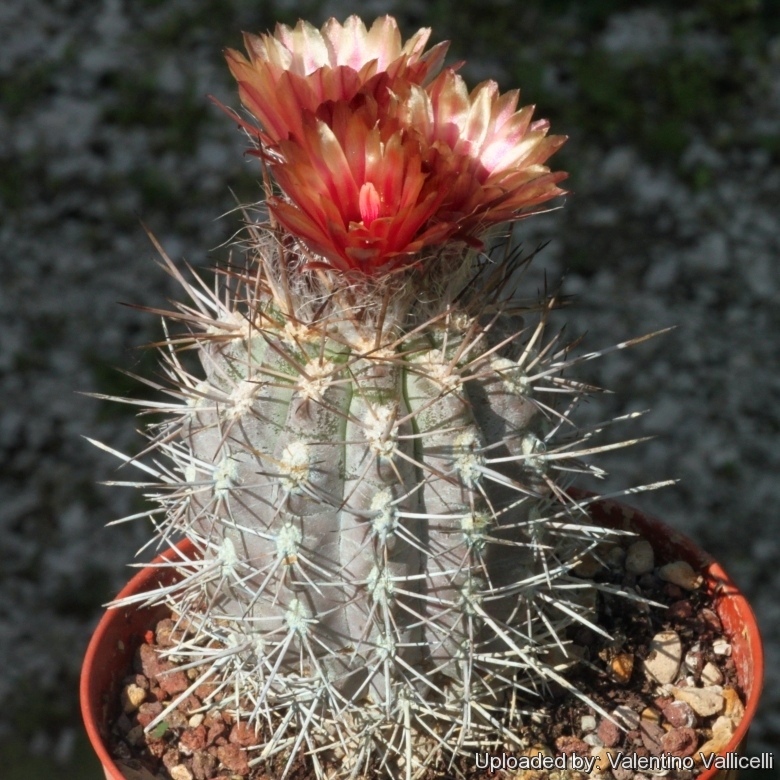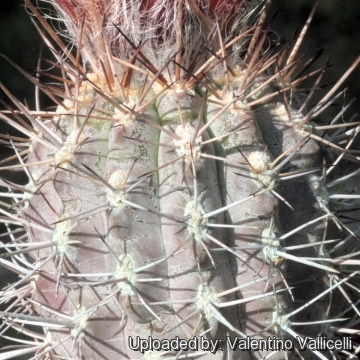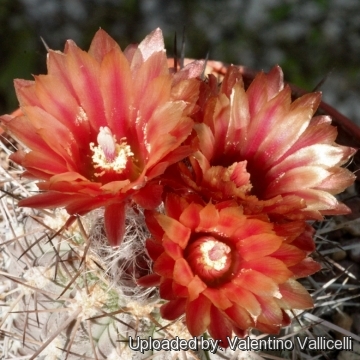Accepted Scientific Name: Eriosyce heinrichiana var. simulans (F.Ritter) Katt.
Eriosyce (Cactac.) gen. revis. & ampl. (Succ. Pl. Res., 1) 1): 118 (1994)

Neoporteria simulans (Eriosyce heinrichiana var. simulans) Photo by: Valentino Vallicelli
Origin and Habitat: Eriosyce simulansSN|2702]]SN|2702]] is endemic to the region of Coquimbo, Chile, from the system of hills and plains of El Trapiche in the north to the Choros Creek in the south, and westward without reaching the coast. It is known from less than five known localities. Extent of occurrence less than 10 km2.
Habitat and ecology: Terraces, slopes and summits of the hills together with Copiapoa pseudocoquimbanaSN|17868]]SN|17868]] and Eulychnia acidaSN|7067]]SN|7067]]. Despite its very restricted distribution, it is locally abundant. It reproduces only by seed that are usually dispersed near the mother plant.
Major current and potential threats: Habitat loss due to road construction, collecting plants for horticulture and grazing of cattle and goats, in particular young plants are eaten or trampled by goats. Unsustainable tourism.
Synonyms:
See all synonyms of Eriosyce heinrichiana
back
Accepted name in llifle Database:Eriosyce heinrichiana (Backeb.) Katt.Eriosyce (Cactac.) gen. revis. & ampl. (Succ. Pl. Res., 1) 118 (1994)Synonymy: 24
Accepted name in llifle Database:Eriosyce heinrichiana subs. intermedia (F.Ritter) Katt.Eriosyce (Cactac.) gen. revis. & ampl. (Succ. Pl. Res., 1) 118 (1994)Synonymy: 5
Accepted name in llifle Database:Eriosyce heinrichiana var. setosiflora (F.Ritter) Katt.Eriosyce (Cactac.) gen. revis. & ampl. (Succ. Pl. Res., 1) 118 (1994)Synonymy: 6
Accepted name in llifle Database:Eriosyce heinrichiana var. simulans (F.Ritter) Katt.Eriosyce (Cactac.) gen. revis. & ampl. (Succ. Pl. Res., 1) 1): 118 (1994)Synonymy: 5
back
Description: Eriosyce heinrichianaSN|2658]]SN|2658]] var. simulans (Neochilenia simulansSN|2703]]SN|2703]]) is a peculiar cactus species often with elongate grey-green stems with long white wool covering the stem tips. The stems and spination simulate in colour and texture the copiapoas that surround them.
It shows beautiful red flowers in spring. Individual plants of this species shows a certain degree of variability depending on origin.
Roots: Fibrous, arising from a large taproot which is narrowed into a necks where joining the stems.
Stem: 4-10 cm in diameter, simple, globose becoming somewhat elongated-cylindrical and branched with age. Epidermis grey-green.
Ribs: Noticeably tubercled with pronounced chinlike protrusions.
Areoles: Orange brown with grey felt.
Spines: Stiff, needle-like, straight and not easily distinguished as centrals or radials. Dark grey.
Radial spines: 8-12, slightly stronger 1-3 cm long.
Central spines: 1-4, weaker 2-4 cm in length.
Flowers: Diurnal, campanulate, 4 cm long and broad, closely packed apically from young areoles, bright red often with red/brownish midveins. Pericarpel and floral tube with bracts, wool and sparsely bristly.
Fruit: Reddish, fleshy, thin walled and splitting open by a basal pore generated by the detachment from the areola.
Bibliography: Major references and further lectures
1) KIESLING R, J LARROCA, L FAÚNDEZ, D METZING & S ALBESIANO Cactaceae. En: Zuloaga FO, M Belgrano & O Morrone (eds) “Catálogo de las Plantas Vasculares del Cono Sur (Argentina, Sur de Brasil, Chile, Paraguay y Uruguay).” Volume 2. Dicotyledonae: Acanthaceae, Fabaceae (Abarema–Schizolobium): 1715-1830. Monographs in Systematic Botany from the Missouri Botanical Garden 107. 2008
2) EGGLI U, M MUÑOZ & B LEUENBERGER “Cactaceae of South America: The Ritter Collections.” in: Englera 16: 1-646. 1995
3) HOFFMANN A “Cactáceas en la flora silvestre de Chile” 1ª ed. Fundación Claudio Gay, 272 pp. 1989
4) BELMONTE E, L FAÚNDEZ, J FLORES, A HOFFMANN, M MUÑOZ & S TEILLIER "Categorías de conservación de cactáceas nativas de Chile". Boletín MNHN 47: 69-89. 1998
5) HOFFMANN A & H WALTER “Cactáceas en la flora silvestre de Chile.” Segunda edición. Ediciones Fundación Claudio Gay, Santiago, Chile. 2004
6) http://www.eriosyce.info/eriosyce/simulans/simulans.htm
7) Fred Kattermann “Eriosyce (Cactaceae): The Genus Revised and Amplified” David Hunt, 1994
8) RITTER F “Kakteen in Südamerika” volume 3 Chile. Spangenberg. 857-1238 1980
9) Pyrrhocactus simulans in: <http://www.mma.gob.cl/clasificacionespecies/fichas8proceso/fichas_finales/Pyrrhocactus_simulans_P08_propuesto.pdf> Downloaded on 01 May 2014.
10) Edward Anderson “The Cactus family” Timber Press, Incorporated, 2001
11) James Cullen, Sabina G. Knees, H. Suzanne Cubey "The European Garden Flora Flowering Plants: A Manual for the Identification of Plants Cultivated in Europe, Both Out-of-Doors and Under Glass" Cambridge University Press, 11/Aug/2011
12) David R Hunt; Nigel P Taylor; Graham Charles; International Cactaceae Systematics Group. "The New Cactus Lexicon" dh books, 2006
 Neoporteria simulans (Eriosyce heinrichiana var. simulans) Photo by: Valentino Vallicelli
Neoporteria simulans (Eriosyce heinrichiana var. simulans) Photo by: Valentino Vallicelli Neoporteria simulans (Eriosyce heinrichiana var. simulans) Photo by: Valentino Vallicelli
Neoporteria simulans (Eriosyce heinrichiana var. simulans) Photo by: Valentino Vallicelli Neoporteria simulans (Eriosyce heinrichiana var. simulans) Photo by: Valentino Vallicelli
Neoporteria simulans (Eriosyce heinrichiana var. simulans) Photo by: Valentino VallicelliSend a photo of this plant.The gallery now contains thousands of pictures, however it is possible to do even more. We are, of course, seeking photos of species not yet shown in the gallery but not only that, we are also looking for better pictures than those already present.
Read More... Cultivation and Propagation: Eriosyce heinrichianaSN|2658]]SN|2658]] var. simulans is a slow growing but relatively easy to grow species, providing they are kept dry during autumn and winter and rot prone if kept in a non ventilated place.
Soils: Require a very fast mineral draining drying soil (70-80% grit and 20-30% of land soil). To prevent rottenness it is also advisable to surround its root neck by very rough sand or grit, this help a fast water drainage and an appropriate air circulation.
Watering Needs: Root prone it needs good drainage, waterings should regular in summer (do not overwater), to keep the plant compact and not become excessively elongated and unnatural in appearance. During the winter quiescent period, or when night temperatures remain below 10° C, it must be strictly kept dry since it is very sensitive to any moisture excesses.
Fertilization: During the beautiful season it’s good to enrich the soil using a fertilizer rich in potassium and phosphorous, but poor in nitrogen, because this chemical element doesn’t help the development of succulent plants, making them too soft and full of water.
Exposure: Requires strong sun exposure to develop good spinal growth (maximum brightness, sunlight accepted), but tolerate light shade. Some light shadow my be useful in the hottest summer days.
Frost Tolerance: Hardy to at least -5°C for a short period but cannot tolerate long standing freezing temperature, and for an healthy cultivation ensure a minimum temperature of 5° C. Assure a good ventilation. USDA Hardiness Zone 9b and 11.
Heat tolerance: Good heat tolerance, but in warmer climates it should be protected from excessive heat and too much sun sun in summer.
Maintenance: Repot in the spring, when its roots become cramped. Generally, it should be repotted every other year in order to provide fresh soil. After repotting, do not water for a week or more.
Propagation: Usually propagated from Seeds. (seldom produces offsets). Sow the seeds in spring in a well-aerated compost at a temperatures of 22-24°C . Stand the pots in water, moisten thoroughly and drain. Scatter and press lightly the seed onto the top of the compost. But do not cover the small seeds with compost. Secure a polythene bag around the pot or cover the container with glass or and place in a warm shaded place. If possible, germinate in a propagator. Some seedlings may appear within a week or 10 days others will take longer. At lower temperatures, germination usually takes considerably longer. Once germination has taken place, remove gradually the glass or plastic and move into a good light but not in direct sun. If the young plants are exposed to too much sun, or the compost dries out, they may stop growing and often turn red; once they stop, it is often difficult to persuade them to start growing again. Never let the pots dry out-but don't saturate them either. A sodden compost is as harmful as a dry one. The seedling growth is rapid. But the seedling are often grafted because the plants on their own roots (especially the bigger ones) are extremely prone to root rot. In fact the best and older specimens are the grafted ones.













